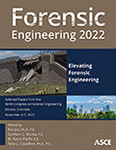Hanging Load Failures in Wood Beams
Publication: Forensic Engineering 2022
ABSTRACT
In the 1971 San Fernando Earthquake, partial roof collapses occurred in concrete tilt-up buildings when wood ledgers bolted to the tops of the tilt-up walls (supporting the edges of the plywood roof diaphragm and tying the roof to the wall) failed as they were subjected to perpendicular-to-grain (cross-grain) bending. Beginning with the 1973 Uniform Building Code, the use of cross-grain bending was prohibited for connecting roof diaphragms to walls. This loading condition is also disallowed through the absence of published design strengths for cross-grain bending and tension in the National Design Specification for Wood Construction. Despite these lessons learned, significantly less attention has been given to avoiding cross-grain tension in everyday loading conditions, such as hanging loads from wood beams. It is common in new and existing construction for the design team to specify HVAC equipment, insulated ceiling systems, fire suppression piping, and other equipment to be hung from wood beams in commercial and industrial buildings. In this paper, recommendations and guidelines for hanging loads from wood beams are summarized from the technical literature used in the US. Case examples of cross-grain tension failures are presented so that explicit building code and design standard provisions can be improved and similar failures can be avoided.
Get full access to this article
View all available purchase options and get full access to this chapter.
REFERENCES
AITC (American Institute of Timber Construction). (2003). Typical Construction Details, AITC 104-03, American Institute of Timber Construction.
ANSI/NDS. (2015). National Design Specification for Wood Construction, American Wood Council.
ANSI/TPI (American National Standards Institute/Truss Plate Institute). (2014). National Design Standard for Metal Plate Connected Wood Truss Construction, ANSI/TPI-1 2014, American National Standards Institute/Truss Plate Institute.
ANSI/TPI (American National Standards Institute/Truss Plate Institute). (2007). Commentary and Appendices to National Design Standard for Metal Plate Connected Wood Truss Construction, ANSI/TPI-1 2007, American National Standards Institute/Truss Plate Institute.
APA. (2007). “Glulam Connection Details,”.
AWC (American Wood Council). (2012). ASD/LRFD Manual for Engineered Wood Construction, 2012 Edition, American Wood Council.
Barrett, J. D. (1974). “Effect of Size on Tension Perpendicular-to-Grain Strength of Douglas-Fir,” Wood and Fiber, Vol. 6(2), pp. 126–143.
EERI (Earthquake Engineering Research Institute). (1996). “Tilt-Up Wall Buildings,” Earthquake Spectra, Earthquake Engineering Research Institute, Vol. 12, Issue 1, Supplementary, pp. 99–123.
Franke, S., Franke, B., and Harte, A. M. (2015). “Failure Modes and Reinforcement Techniques for Timber Beams – State of the Art,” Construction and Building Materials, 97, pp. 2–13.
Gerlich, J. T. (1988). “The Performance of Bolted Timber Joints with Departures from New Zealand Code Requirements,”, Building Research Association of New Zealand.
Green, D. W. (2001). “Wood: Strength and Stiffness,” In Encyclopedia of Materials: Science and Technology, pp. 9732–9736.
Jensen, J. L., Girhammar, U. A., Quenneville, P., and Källsner, B. (2012). “Splitting of Beams Loaded Perpendicular to Grain by Connections – Simple Fracture Mechanics Models,” World Conference on Timber Engineering, Session 10, Connections 3, July 18-19, pp. 388–397.
Lawson, J. W., and McCormick, D. L. (2019). “Tilt-Up Concrete Wall Anchorage Design: A Trial and Error Process,”, April, pp. 20-23.
Madsen, B. (2000). Behaviour of Timber Connections, Chapter 5, Timber Engineering Ltd.
Okamoto, S., Akiyama, N., Nakamura, N., Aoki, K., and Inayama, M. (2021). “Estimation of the Perpendicular-to-the-Grain Tensile Strength of Scots Pine Glued Laminated Timber via Three-Point Bending Tests,” Journal of Wood Science, 67:33.
Soltis, L. A., and Wilkinson, T. L. (1987). “Bolted-Connection Design,”, Forest Service, Forest Products Laboratory.
UBC (Uniform Building Code). (1973). Uniform Building Code, International Conference of Building Officials, Fifth Printing.
Wilkinson, T. L. (1992). “Strength of Bolted Timber Connections with Steel Side Members,”, Forest Service, Forest Products Laboratory.
Information & Authors
Information
Published In
History
Published online: Nov 2, 2022
Authors
Metrics & Citations
Metrics
Citations
Download citation
If you have the appropriate software installed, you can download article citation data to the citation manager of your choice. Simply select your manager software from the list below and click Download.
